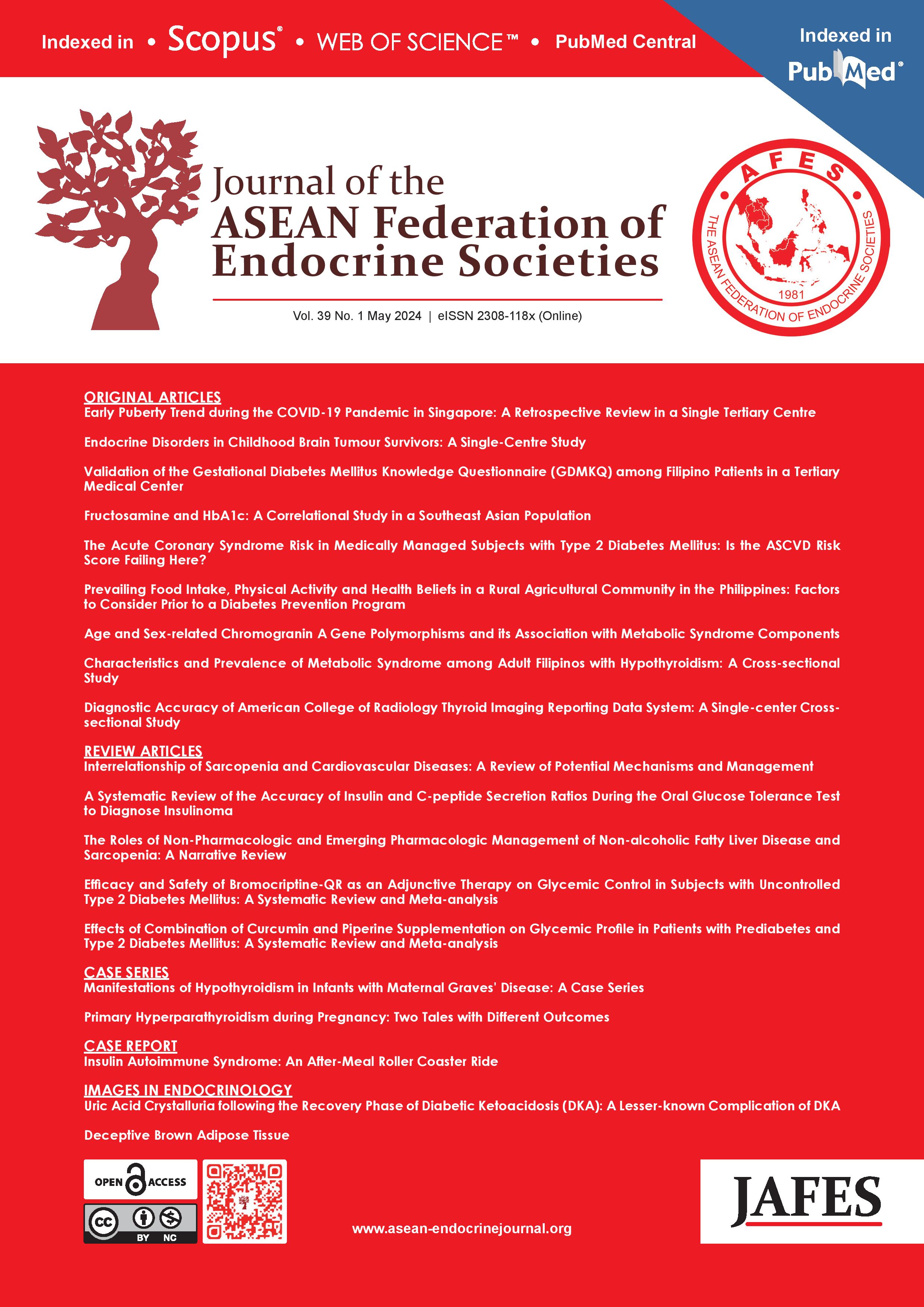Prevailing Food Intake, Physical Activity and Health Beliefs in a Rural Agricultural Community in the Philippines
Factors to Consider Prior to a Diabetes Prevention Program
DOI:
https://doi.org/10.15605/jafes.039.01.11Keywords:
beliefs, diabetes prevention, diet, lifestyle, prediabetes, rural communityAbstract
Objective. A diabetes prevention program is being proposed in the rural agricultural town of San Juan, Batangas, Philippines. This study aims to determine the prevailing level of food intake, physical activity, and health beliefs prior to any intervention.
Methodology. Adults were recruited via random sampling with proportional allocation. Interviews were done to determine food intake and physical activity. Small group discussions were held to determine prevailing health beliefs.
Results. The average energy intake (1,547 kcal/d) is only 72% of the recommended values for Filipinos. Only 12% of the respondents achieved the recommended energy intake. Carbohydrates comprise a large part (71%) of calorie intake. A majority (91%) already have moderate to high levels of physical activity. There are prevailing health beliefs that need to be considered when dietary modifications and physical activity interventions are to be done.
Conclusion. Internationally recommended diabetes prevention interventions such as reducing calorie intake and increasing physical activity may not be directly applicable here. We recommend that the features of a diabetes prevention program for this locale must include the following: 1) introduction of affordable plant sources of proteins; 2) decreasing the proportion of rice as a source of carbohydrates in the diet; 3) maintaining the level of physical activity; and 4) being sensitive to the prevailing health beliefs.
Downloads
References
Dans AL, Morales DD, Velandria F, et al. National Nutrition and Health Survey (NNHeS): Atherosclerosis – related diseases and risk factors. Philipp J Intern Med. 2005;43:103-15.
Sy RG, Morales DD, Dans AL, et al. Prevalence of atherosclerosis-related risk factors and diseases in the Philippines. J Epidemiol. 2012;22(5):440‐7. https://pubmed.ncbi.nlm.nih.gov/22813647. https://www.ncbi.nlm.nih.gov/pmc/articles/PMC3798639. https://doi.org/10.2188/jea.je20110095.
Ardena GJR, Paz-Pacheco E, Jimeno CA, Lantion-Ang FL, Paterno E, Juban N. Knowledge, attitudes and practices of persons with type 2 diabetes in a rural community: Phase I of the community-based Diabetes Self-Management Education (DSME) program in San Juan, Batangas, Philippines. Diabetes Res Clin Pract. 2010;90(2):160-6. https://pubmed.ncbi.nlm.nih.gov/20828851. https://doi.org/10.1016/j.diabres.2010.08.003.
Sandoval MAS, Paz-Pacheco E, Ardena GJR, et al. Socio-economic realities in a rural Filipino community lead volunteer bias in a survey of diabetes, prediabetes and metabolic syndrome. Soc Med. 2016;10(1):30-5.
Paz-Pacheco E, Sandoval MAS, Ardena GJR, et al. Effectiveness of a community-based diabetes self-management education (DSME) program in a rural community. Prim Health Care Res Dev. 2017;18(1):35-49. https://pubmed.ncbi.nlm.nih.gov/27640303. https://doi.org/10.1017/S1463423616000335.
American Diabetes Association. 5. Prevention or delay of type 2 diabetes. Diabetes Care. 2017;40(Suppl 1):S44-7. https://pubmed.ncbi.nlm.nih.gov/27979892. https://doi.org/10.2337/dc17-S008.
Philippine Statistics Authority. 2010 Census of Population and Housing. Statistical tables on sample variables from the results of the 2010 census of population and housing – Batangas. Accessed May 11, 2023. https://psa.gov.ph/content/statistical-tables-sample-variables-results-2010-census-population-and-housing-batangas.
Portugal T, Apilado R, Avena E, et al. The Philippine Food Composition Tables. Taguig: Food and Nutrition Research Institute, Department of Science and Technology; 1997.
Food and Nutrition Research Institute. Recommended Energy and Nutrient Intakes 2003. Compendium of Philippine Medicine; 2006.
International Physical Activity Questionnaire. Accessed January 3, 2012. https://sites.google.com/view/ipaq.
Craig CL, Marshall AL, Sjöström M, et al. International physical activity questionnaire: 12-country reliability and validity. Med Sci Sports Exerc. 2003;35(8):1381-95. https://pubmed.ncbi.nlm.nih.gov/12900694. https://doi.org/10.1249/01.MSS.0000078924.61453.FB.
Downloads
Published
How to Cite
Issue
Section
License
Copyright (c) 2022 Mark Anthony Sandoval, Elizabeth Paz-Pacheco, Edwin Canete, Perpetua Patal, Monica Therese Cating-Cabral, Frances Lina Lantion-Ang, Elizabeth Paterno, Noel Juban+, Cecilia Jimeno

This work is licensed under a Creative Commons Attribution-NonCommercial 4.0 International License.
The full license is at this link: http://creativecommons.org/licenses/by-nc/3.0/legalcode).
To obtain permission to translate/reproduce or download articles or use images FOR COMMERCIAL REUSE/BUSINESS PURPOSES from the Journal of the ASEAN Federation of Endocrine Societies, kindly fill in the Permission Request for Use of Copyrighted Material and return as PDF file to jafes@asia.com or jafes.editor@gmail.com.
A written agreement shall be emailed to the requester should permission be granted.











